Alan Humphries Takes Us To See The Dutch Bruin Vloot
30th August 2024
In: News, Members' Articles
The Bruin Vloot/Brown Fleet – Alan D. Humphries
The Bruin Vloot is the affectionate name given to a fleet of ex-cargo vessels now plying their trade in the Netherlands, especially on the Wadden Sea, the Ijsselmeer and the Markermeer.
Why Bruin Vloot? Well the sails were originally made of cotton, unfortunately these took on water in bad weather, which could make the vessel unstable. To avoid this the sails were tanned with catechu, a colourant from the bark of tropical acacia woods to make them waterproof and more durable. The longer the sails were subject of this treatment the dark they became. Today’s materials make this process redundant, even so you will still see vessels sporting brown sails.
My information is that there are over 500 vessel plying the charter trade which allows you to charter (rent) the ship fully manned and equipped for a day, weekend trips, midweek trip or seven days. This makes them highly suitable for corporate events, school trips, staff outings or family outings.
There are many types of vessel employed in the charter business, which has its origins in a very small scale as early as the second half of the nineteenth century, when the well-off would pay a skipper owner to take them on a trip.
All the "Bruin Vloot” are ex-cargo vessels or in some instances fishing vessels. Originally pure sail, eventually the availability of auxiliary engines saw these being installed. This of course gave the vessels greater flexibility and increased earnings.
In 1960s and 1970s, the sailing auxiliaires fell victim to the purpose-built motor coasters and barge vessels; economies of scale and innovation in inland navigation
A scrapping scheme was introduced for unprofitable inland vessels and so many went to the scrap yard. Other ships survived, bought by groups of people, often 'hippies', with a love of old ships and a wish for a simpler, more alternative existence.
Some of the vessels which were not scrapped, were used for passengers instead of cargo, although the accommodation on most could at best be described as basic; such trips grew in popularity. The 1980s and 1990s saw an increased focus on more comfort on board. Some ships were, at considerable cost, completely rebuilt and adapted to modern requirements, others remained virtually untouched or were restored on a small scale by the skipper. All vessels of course have to comply with the latest maritime regulations.
The Netherlands thus has a great diversity of ships within the Brown Fleet.
Hence, due largely to the efforts of ‘bruin vloot skippers' there is a new economic existence for these vessels. From the large 1970’s the Enkhuizer Zeevaartschool started to offer training courses for the Brown Fleet and in 1979 the professional charter trade association was established to consult with governments and anticipate developments.
As mentioned earlier the “bruin Vloot” ply their trade on the Ijsselmeer, Markermeer and the Wadden Sea, visiting many historic ports. The Wadden Zee is a World Heritage site on whose shores is situation Harlingen. Being tidal, flat bottomed vessels can run aground at low water allowing the passengers to enjoy this wonderful maritime nature reserve
Harlingen, while it has adapted to accommodate the changing maritime scene, has a rich nautical past which is still evident there are many warehouses and canal houses and access via the inland waterways to many other unique historic ports. Harlingen is home to the largest Brown Fleet in the Netherlands, comprising of over seventy historic vessels. Harlingen is very proud that it is home to these historic sailing ships. Together, the historic sailing ships form a unique scene in the ports of Harlingen, on the mudflats, and on other Frisian waters.
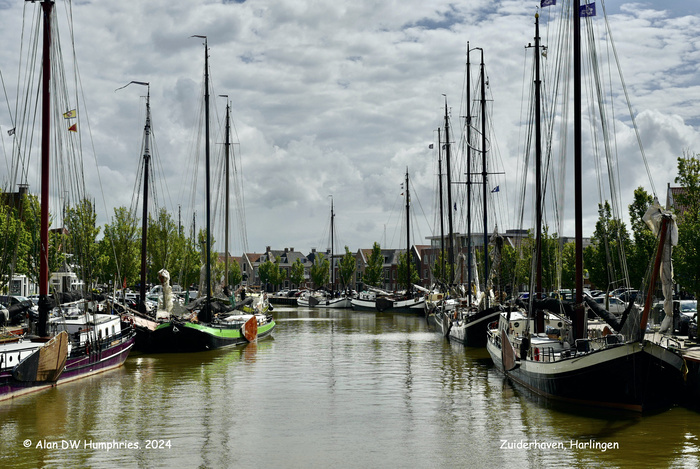
Zuiderhaven, Harlingen
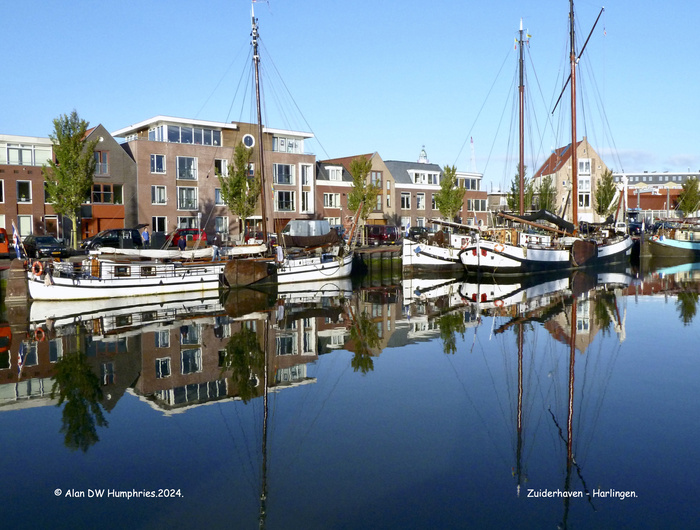
Zuiderhaven
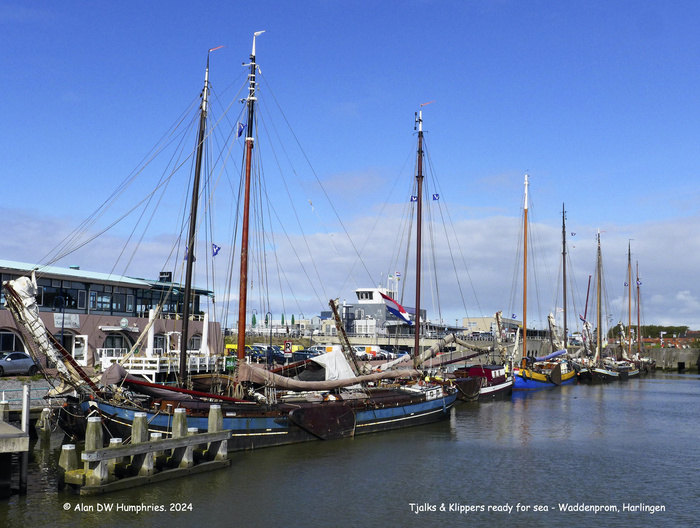
Tjalks & Klippers Waddenprom
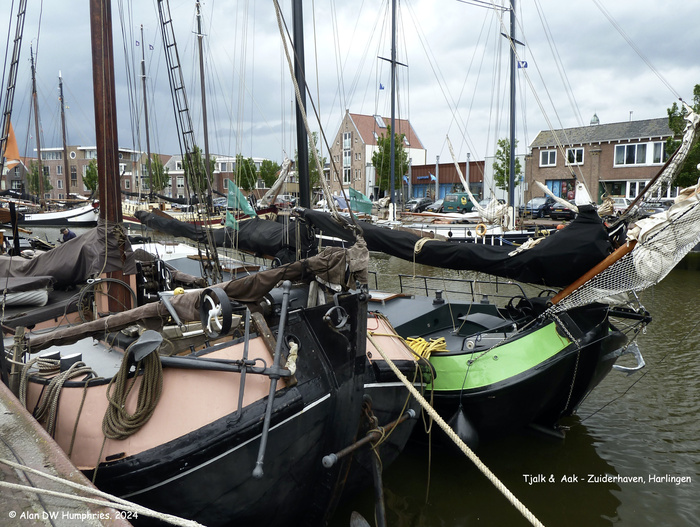
Tjalk & Aak- Zuiderhaven
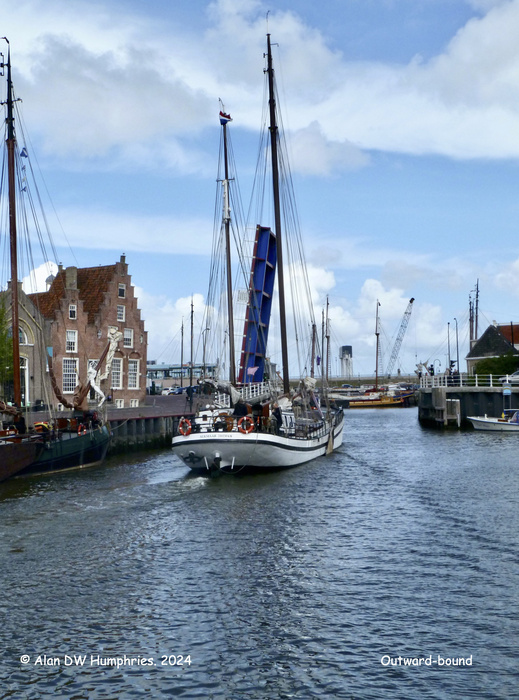
Outward-bound
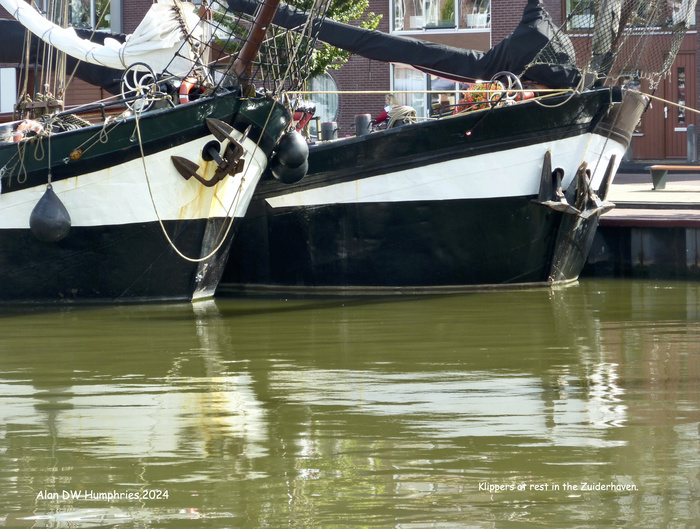
Klippers-Zuiderhavn
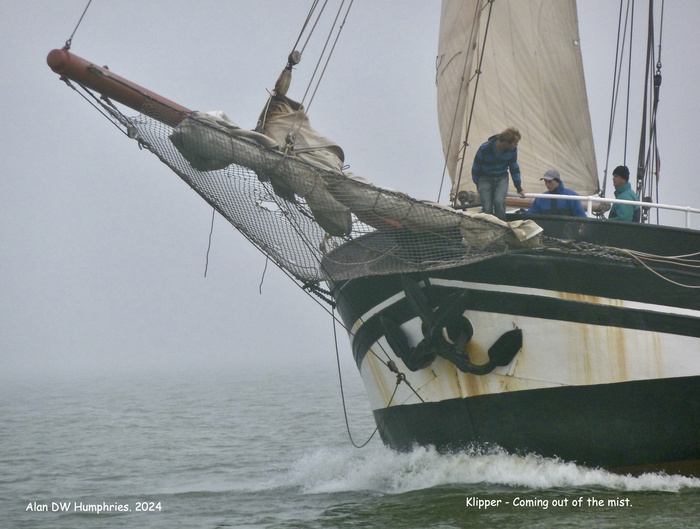
Klipper coming out of the mist

Aak under sail
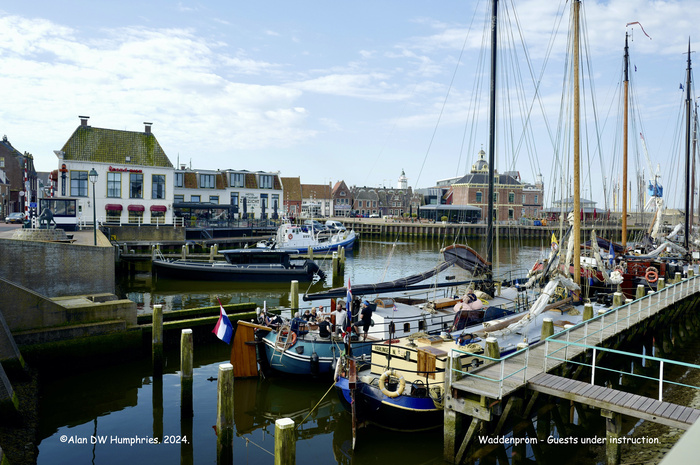
Guests Under Instruction
©Alan DW Humphries 2024.
The Bruin Vloot is the affectionate name given to a fleet of ex-cargo vessels now plying their trade in the Netherlands, especially on the Wadden Sea, the Ijsselmeer and the Markermeer.
Why Bruin Vloot? Well the sails were originally made of cotton, unfortunately these took on water in bad weather, which could make the vessel unstable. To avoid this the sails were tanned with catechu, a colourant from the bark of tropical acacia woods to make them waterproof and more durable. The longer the sails were subject of this treatment the dark they became. Today’s materials make this process redundant, even so you will still see vessels sporting brown sails.
My information is that there are over 500 vessel plying the charter trade which allows you to charter (rent) the ship fully manned and equipped for a day, weekend trips, midweek trip or seven days. This makes them highly suitable for corporate events, school trips, staff outings or family outings.
There are many types of vessel employed in the charter business, which has its origins in a very small scale as early as the second half of the nineteenth century, when the well-off would pay a skipper owner to take them on a trip.
All the "Bruin Vloot” are ex-cargo vessels or in some instances fishing vessels. Originally pure sail, eventually the availability of auxiliary engines saw these being installed. This of course gave the vessels greater flexibility and increased earnings.
In 1960s and 1970s, the sailing auxiliaires fell victim to the purpose-built motor coasters and barge vessels; economies of scale and innovation in inland navigation
A scrapping scheme was introduced for unprofitable inland vessels and so many went to the scrap yard. Other ships survived, bought by groups of people, often 'hippies', with a love of old ships and a wish for a simpler, more alternative existence.
Some of the vessels which were not scrapped, were used for passengers instead of cargo, although the accommodation on most could at best be described as basic; such trips grew in popularity. The 1980s and 1990s saw an increased focus on more comfort on board. Some ships were, at considerable cost, completely rebuilt and adapted to modern requirements, others remained virtually untouched or were restored on a small scale by the skipper. All vessels of course have to comply with the latest maritime regulations.
The Netherlands thus has a great diversity of ships within the Brown Fleet.
Hence, due largely to the efforts of ‘bruin vloot skippers' there is a new economic existence for these vessels. From the large 1970’s the Enkhuizer Zeevaartschool started to offer training courses for the Brown Fleet and in 1979 the professional charter trade association was established to consult with governments and anticipate developments.
As mentioned earlier the “bruin Vloot” ply their trade on the Ijsselmeer, Markermeer and the Wadden Sea, visiting many historic ports. The Wadden Zee is a World Heritage site on whose shores is situation Harlingen. Being tidal, flat bottomed vessels can run aground at low water allowing the passengers to enjoy this wonderful maritime nature reserve
Harlingen, while it has adapted to accommodate the changing maritime scene, has a rich nautical past which is still evident there are many warehouses and canal houses and access via the inland waterways to many other unique historic ports. Harlingen is home to the largest Brown Fleet in the Netherlands, comprising of over seventy historic vessels. Harlingen is very proud that it is home to these historic sailing ships. Together, the historic sailing ships form a unique scene in the ports of Harlingen, on the mudflats, and on other Frisian waters.

Zuiderhaven, Harlingen

Zuiderhaven

Tjalks & Klippers Waddenprom

Tjalk & Aak- Zuiderhaven

Outward-bound

Klippers-Zuiderhavn

Klipper coming out of the mist

Aak under sail

Guests Under Instruction
©Alan DW Humphries 2024.
Comments
 By Ken Davis: Alan,
your photographs and description make this sound very tempting. It's good to see that some of the Brown Fleet has found a new life.
By Ken Davis: Alan,
your photographs and description make this sound very tempting. It's good to see that some of the Brown Fleet has found a new life. By Tony Tarlton: Many thanks, Alan, for a very interesting article and with lovely pictures.
By Tony Tarlton: Many thanks, Alan, for a very interesting article and with lovely pictures. By Cled Lewis: Another fascinating article Alan and again with a link to the sea. The information about the boats and how so many were saved is something that Europe appears to do more effectively than us.
As for the spelling I am lost in admiration.
The pictures are great particularly the one “under sail”
Thank you.
Cled
By Cled Lewis: Another fascinating article Alan and again with a link to the sea. The information about the boats and how so many were saved is something that Europe appears to do more effectively than us.
As for the spelling I am lost in admiration.
The pictures are great particularly the one “under sail”
Thank you.
Cled By David Askham: Thank you, Alan for your review of historic vessels which, I guess, few people in the UK will have heard about. I guess British contemporary equivalents have mostly been scrapped. I was interested in the use of acacia sap for waterproofing old cotton sails.
By David Askham: Thank you, Alan for your review of historic vessels which, I guess, few people in the UK will have heard about. I guess British contemporary equivalents have mostly been scrapped. I was interested in the use of acacia sap for waterproofing old cotton sails. By David Askham: Thank you, Alan for your review of historic vessels which, I guess, few people in the UK will have heard about. I guess British contemporary equivalents have mostly been scrapped. I was interested in the use of acacia sap for waterproofing old cotton sails.
By David Askham: Thank you, Alan for your review of historic vessels which, I guess, few people in the UK will have heard about. I guess British contemporary equivalents have mostly been scrapped. I was interested in the use of acacia sap for waterproofing old cotton sails. By Keith Walker: Very good read, Alan, supported by some superb images!
By Keith Walker: Very good read, Alan, supported by some superb images! By Cholwo: Lovely Alan, Keep going strong.
By Cholwo: Lovely Alan, Keep going strong.